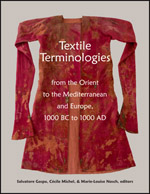Center, Textile Research

Textile Terminologies from the Orient to the Mediterranean and Europe, 1000 BC to 1000 AD
Date of this Version
2017
Document Type
Article
Citation
In Textile Terminologies from the Orient to the Mediterranean and Europe, 1000 BC to 1000 AD, ed. Salvatore Gaspa, Cécile Michel, & Marie-Louise Nosch (Lincoln, NE: Zea Books, 2017), pp. 492-499.
doi:10.13014/K2H41PKC
Abstract
In this passage the Latin term oscillum refers to a particular class of objects: a small face or mask hung on trees during certain religious feasts celebrated by the Ausones in honour of Bacchus (Fig. 1). The Roman oscilla most probably derives from the Aἰῶραι, small images related to Dionysus hung on trees during the Aἰῶρα, an Athenian public feast. They were believed to purify the air as they swung in the wind. Both the Greek and the Latin words refer to objects used during particular sacred feasts, in the first case public and in the second case private, inside villae. However, the term oscillum has also been applied to certain shapes (circular and semicircular) of loom weights (Fig. 2). Italian archaeologists in particular have traditionally used the term oscillum to refer to these weights, reserving the term ‘peso da telaio’ (loom weight) for the traditional shapes (truncated pyramid and truncated cone). Most of the archaeological literature identifies circular and semicircular loom weights as such, although there have been contrasting interpretations of their function ever since the late 19th century. What caused the term oscilla to be transferred from sacred objects to loom weights must surely have been the latter’s unconventional shape and their decorations and inscriptions. But when and why did this take place?
Included in
Ancient History, Greek and Roman through Late Antiquity Commons, Art and Materials Conservation Commons, Classical Archaeology and Art History Commons, Classical Literature and Philology Commons, Fiber, Textile, and Weaving Arts Commons, Indo-European Linguistics and Philology Commons, Jewish Studies Commons, Museum Studies Commons, Near Eastern Languages and Societies Commons, Other History of Art, Architecture, and Archaeology Commons


Comments
Copyright © 2017 Salvatore Gaspa, Cécile Michel, & Marie-Louise Nosch. Photographs copyright as noted.